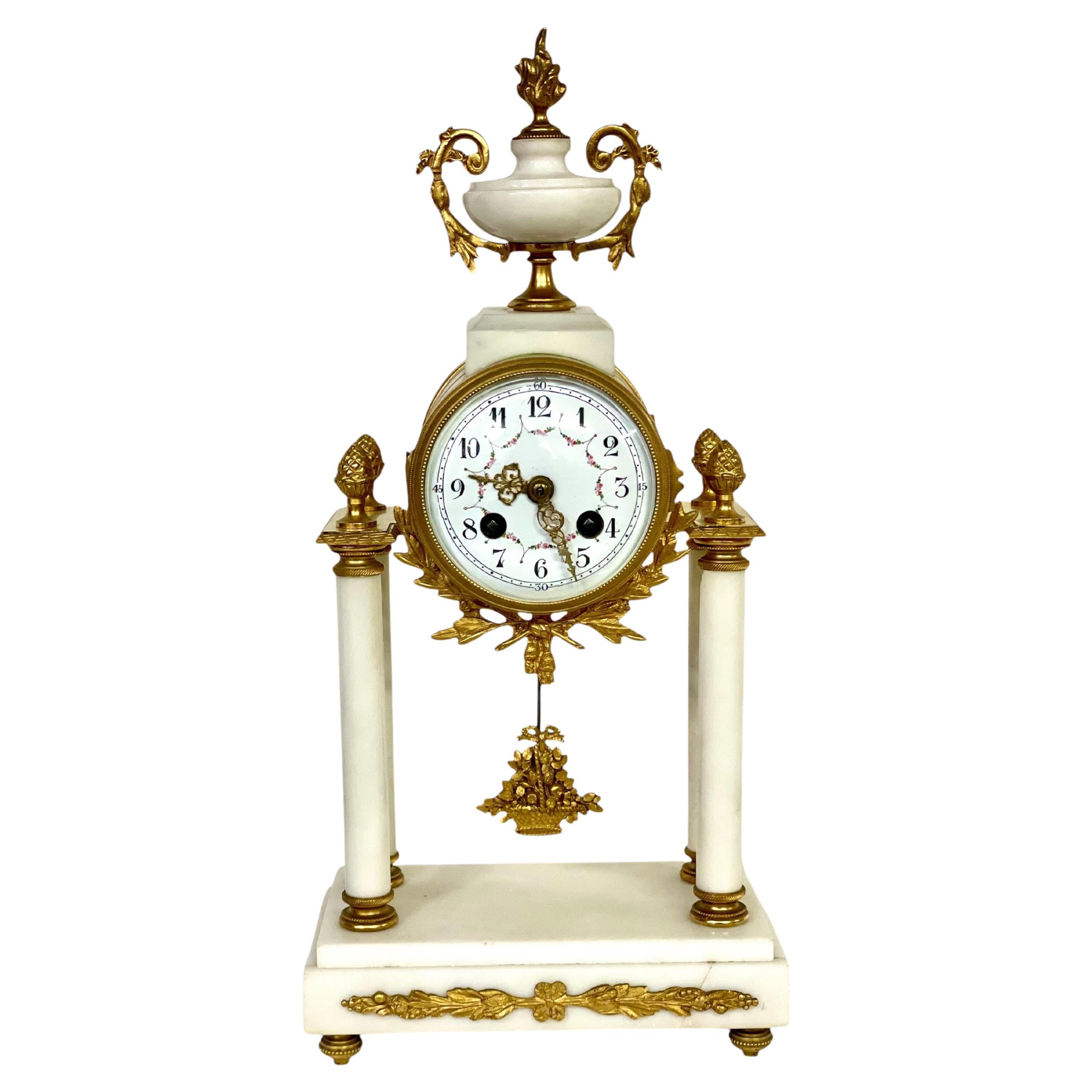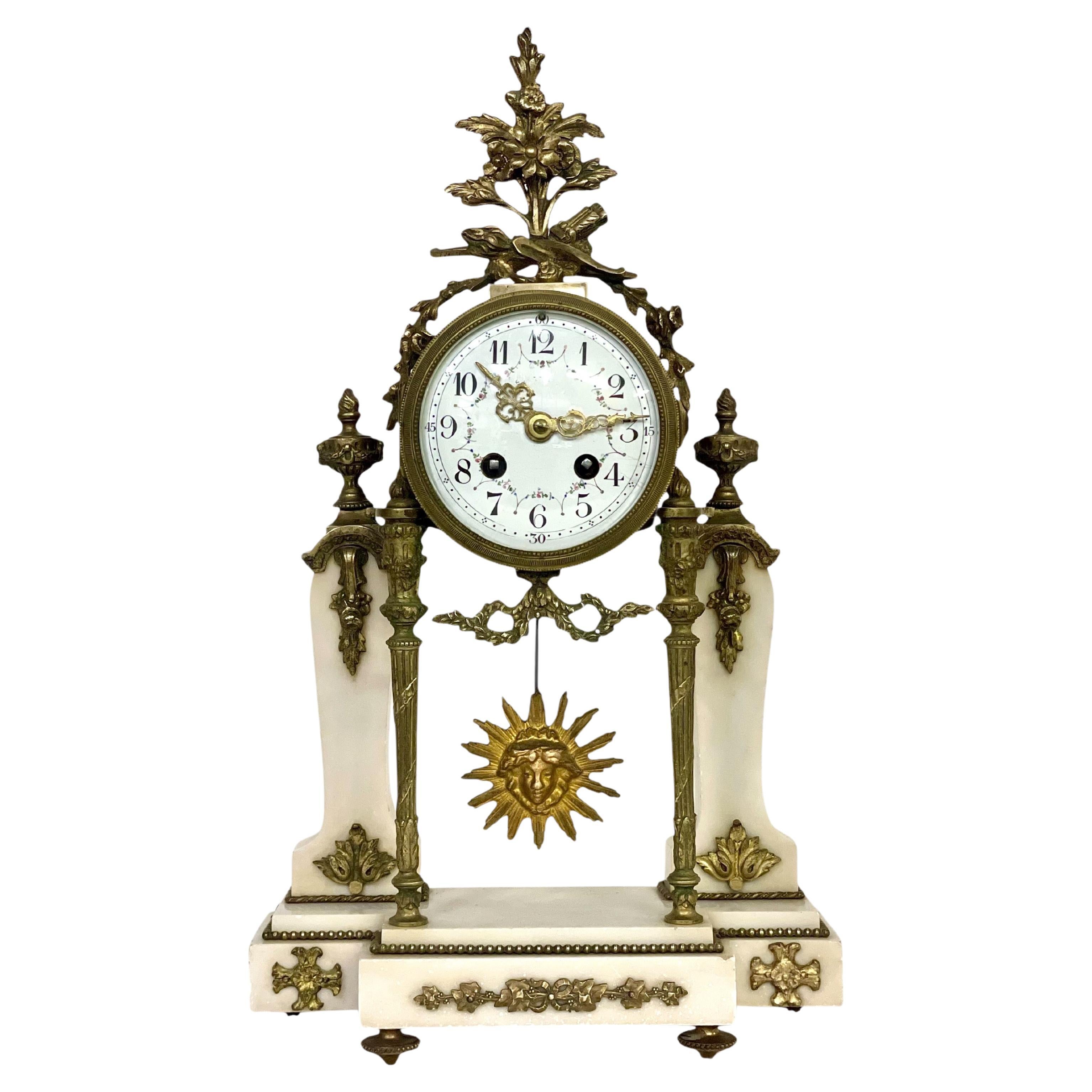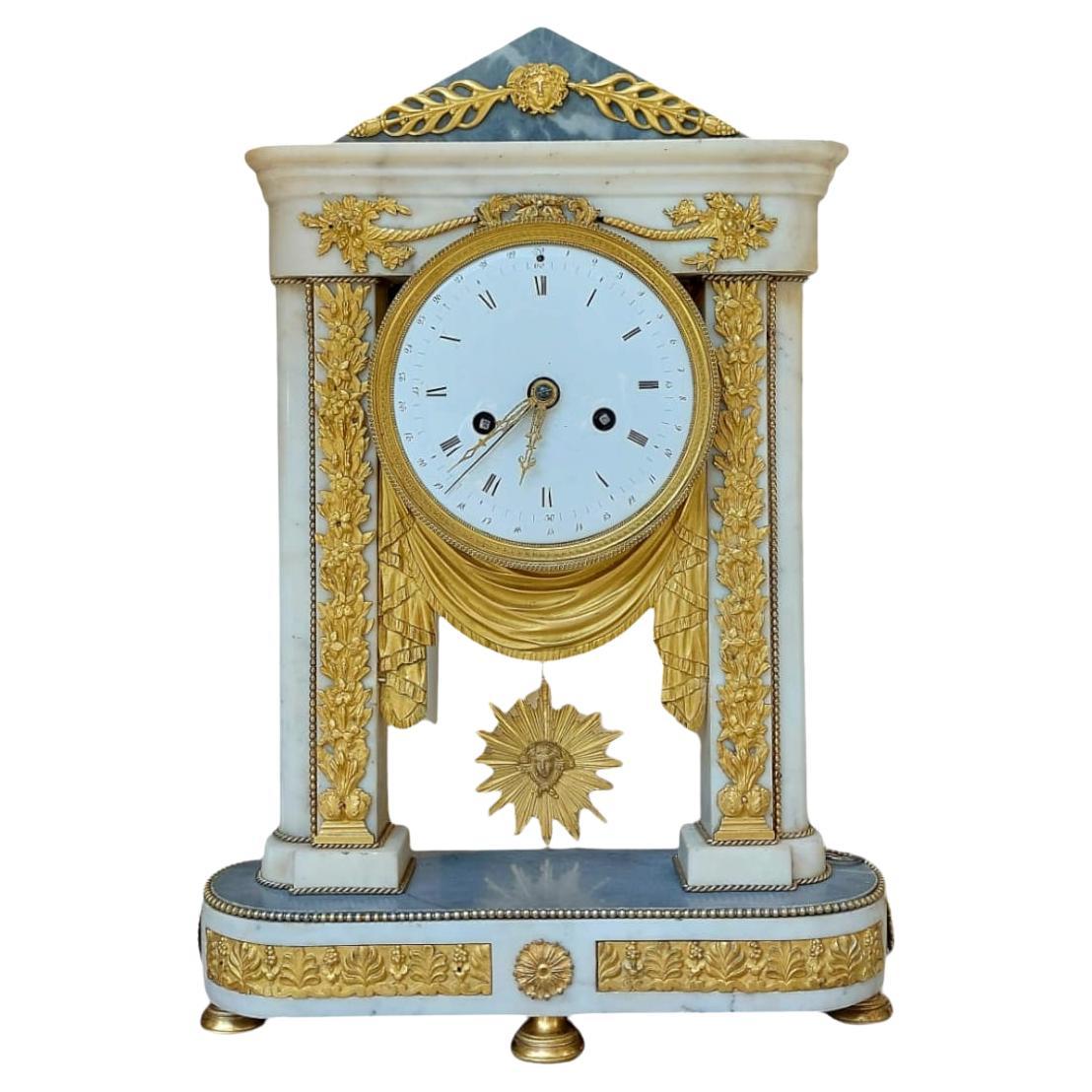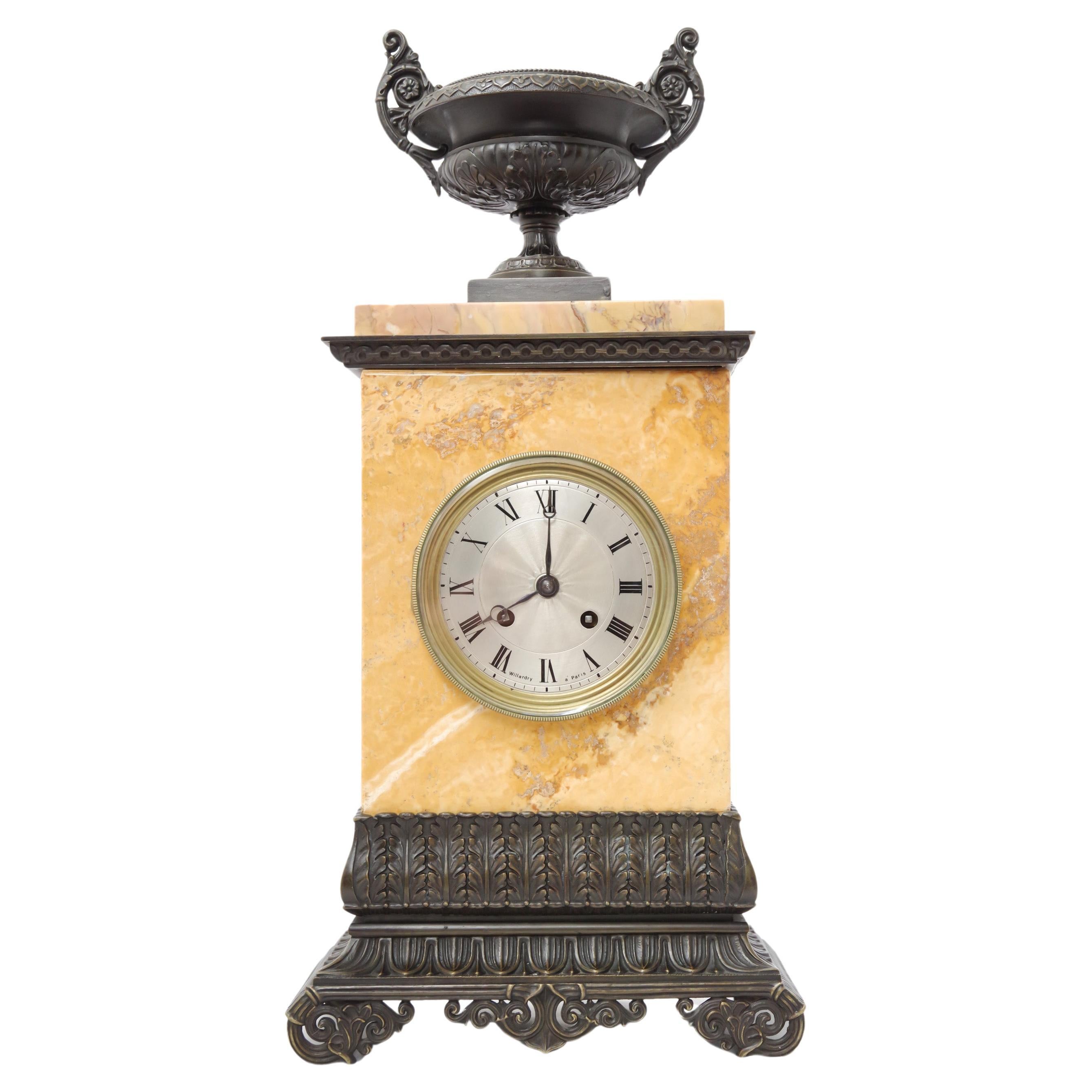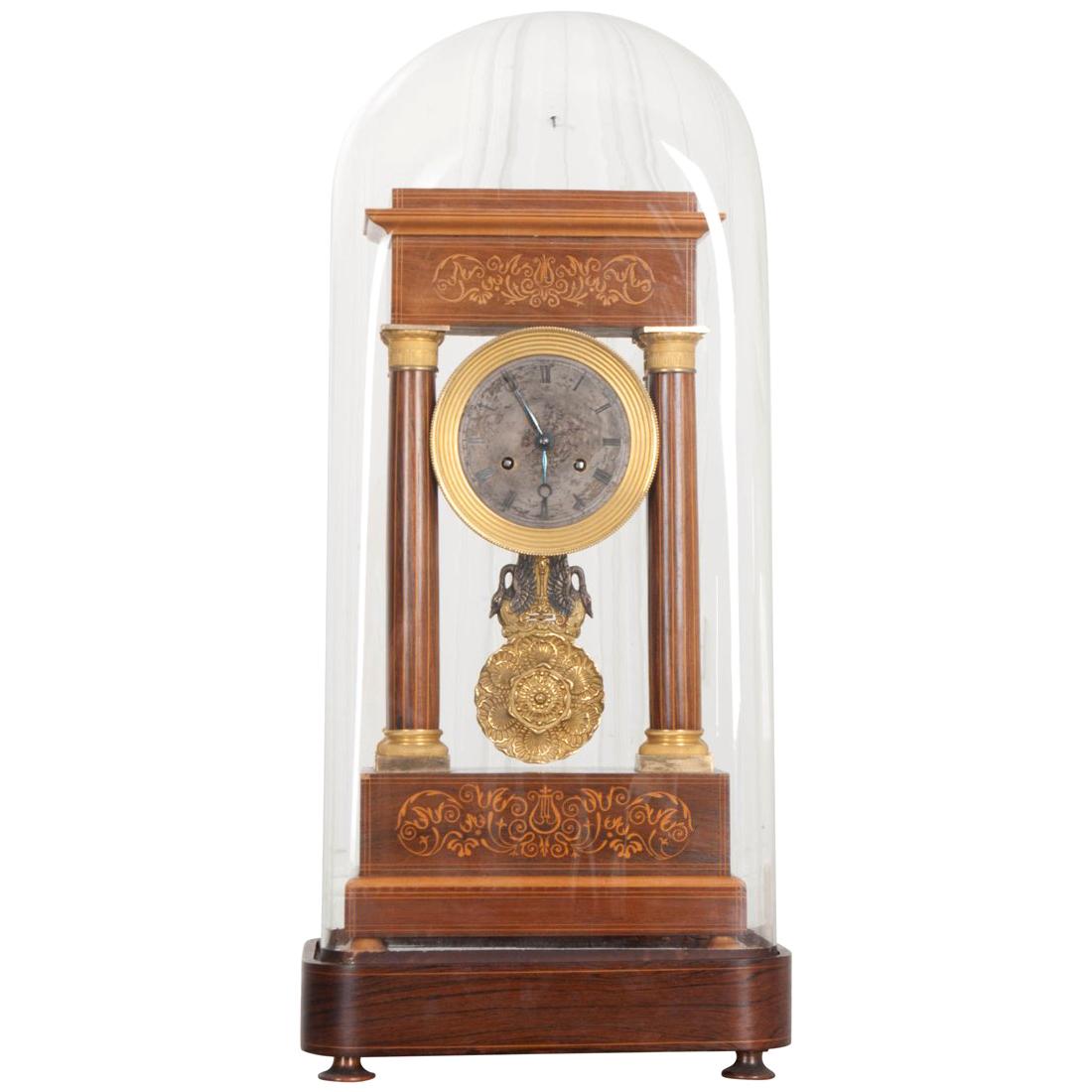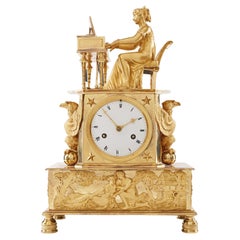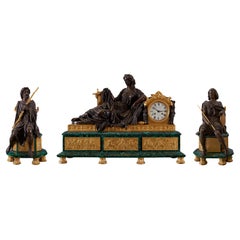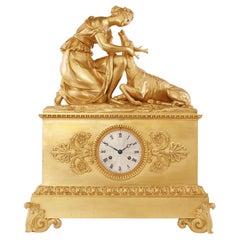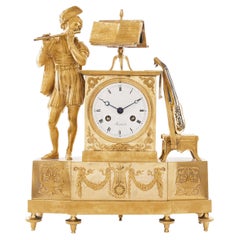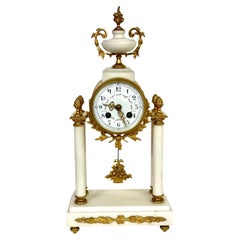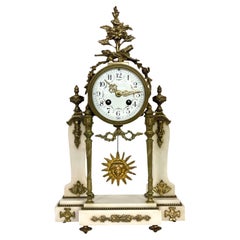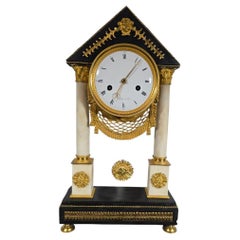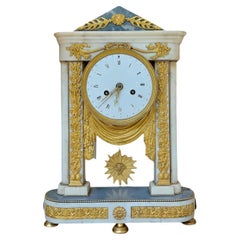Items Similar to 19th Century Gilt Bronze and White Marble Portico Clock
Want more images or videos?
Request additional images or videos from the seller
1 of 8
19th Century Gilt Bronze and White Marble Portico Clock
$1,870.05
$2,996.8837% Off
£1,389.19
£2,226.2637% Off
€1,560
€2,50037% Off
CA$2,596.78
CA$4,161.5137% Off
A$2,833.69
A$4,541.1737% Off
CHF 1,486.32
CHF 2,381.9237% Off
MX$34,416.11
MX$55,154.0237% Off
NOK 18,564.93
NOK 29,751.4937% Off
SEK 17,544.79
SEK 28,116.6437% Off
DKK 11,876.12
DKK 19,032.2437% Off
About the Item
This striking mantel clock is a true testament to the exquisite craftsmanship and refined aesthetic of the Empire period in 19th-century France. The clock showcases a harmonious blend of form and function, typical of the style, with a strong emphasis on classical motifs and decorative elements.
The clock is presented in a classic architectural form, with two elegant columns supporting a central archway adorned with a row of stars. The columns are adorned with gilded bronze capitals and bases, adding a touch of opulence. Above the dial, a decorative frieze featuring stylized winged creatures and stars adds a dramatic and decorative element.
The clock rests on a rectangular base crafted from white marble, creating a visually striking contrast. The base is further embellished with gilded bronze mounts, featuring intricate motifs of acanthus leaves, floral swags, and possibly other decorative elements.
Key Features:
Empire Style: The clock exemplifies the elegance and grandeur of the Empire style, a period celebrated for its neoclassical influences and refined aesthetic.
White Marble Construction: The use of white marble lends the clock a sense of timeless elegance and sophistication.
Gilded Bronze Accents: The gilded bronze accents add a touch of opulence and highlight the intricate details of the design.
Architectural Design: The portico-like structure with columns and a star-studded archway creates a unique and visually striking aesthetic.
Decorative Potential: This clock would make a stunning addition to any grand residence, serving as a centerpiece on a mantelpiece, console table, or as part of a larger display.
- Dimensions:Height: 15.75 in (40 cm)Width: 10.24 in (26 cm)Depth: 3.94 in (10 cm)
- Style:Louis XVI (In the Style Of)
- Materials and Techniques:
- Place of Origin:
- Period:
- Date of Manufacture:circa 1700
- Condition:Repaired.
- Seller Location:Warsaw, PL
- Reference Number:1stDibs: LU5826225165302
About the Seller
5.0
Vetted Professional Seller
Every seller passes strict standards for authenticity and reliability
Established in 2021
1stDibs seller since 2021
34 sales on 1stDibs
Typical response time: 10 hours
- ShippingRetrieving quote...Shipping from: Warsaw, Poland
- Return Policy
Authenticity Guarantee
In the unlikely event there’s an issue with an item’s authenticity, contact us within 1 year for a full refund. DetailsMoney-Back Guarantee
If your item is not as described, is damaged in transit, or does not arrive, contact us within 7 days for a full refund. Details24-Hour Cancellation
You have a 24-hour grace period in which to reconsider your purchase, with no questions asked.Vetted Professional Sellers
Our world-class sellers must adhere to strict standards for service and quality, maintaining the integrity of our listings.Price-Match Guarantee
If you find that a seller listed the same item for a lower price elsewhere, we’ll match it.Trusted Global Delivery
Our best-in-class carrier network provides specialized shipping options worldwide, including custom delivery.More From This Seller
View AllMantel Clock 19th Century Styl Empire
Located in Warsaw, PL
This nineteenth-century gilded bronze clock exemplifies the grandeur of the Empire style, featuring a rectangular base with four legs, each intricately carved with subtle patterns. A...
Category
Antique Early 19th Century French Empire Mantel Clocks
Materials
Bronze
Three-Piece Clock Garniture 19th Century.
Located in Warsaw, PL
Signed Three-Piece Clock Garniture 19th Century.
Malachite is a gemstone known for its vibrant green color and unique banding. In feng shui and metaphysical beliefs, malachite is h...
Category
Antique 19th Century French Napoleon III Mantel Clocks
Materials
Malachite, Bronze
$28,158 / set
Mantel Clock 19th Century Transitional Period
Located in Warsaw, PL
This elegant mantel clock is a fine example of the Empire style, a period characterized by its grandeur and inspiration from classical antiquity. The clock showcases a masterful comb...
Category
Antique Early 18th Century French Industrial Mantel Clocks
Materials
Bronze
Mantel Clock 19th Century Styl Empire by Ferdinand Berthoud À Paris
Located in Warsaw, PL
Ormolu bronze mantel clock flanked by a troubadour and musical instruments, signed 'Ferdinand Berthoud a Paris'.
The end of the 18th and beginning of the 19th century was a crucial time in which new technological advances helped to make watches more accurate and more portable. During the 1790s, the production of gilded bronze increased considerably as working conditions improved. The freedom of trade initiated by the French Revolution allowed many casters to develop large factories. The new factory environment gave them a chance to execute all stages of bronze work including drawing, casting, gilding, assembly, and trade of art objects. While the bronzers took creative liberty in creating all kinds of clocks in contrast to the noble and rigorous structure carried by the movement of neoclassicism. Under the reign of Empire, the case designs started gradually to develop away from a proportionate and strict classicism towards a baroque style and revival style. The rediscovery of medieval civilization was one of the intellectual curiosities of the beginning of the 19th century, with much input from the Ancien Régime and its institutions, rites and the medieval churches in which family ceremonies occurred.
This early nineteenth-century figural mantel clock is surmounted by a medieval musician. To be more precise, it is a french troubadour. Troubadours were known for composing and performing lyric poetry for the nobility back during medieval times. The clock is featuring a chiselled bronze troubadour, dressed in medieval fashion while holding a flute, playing a tune from sheet music called "Du Troubadour" that is resting on top of the rectangular clock case. In addition to that, the clock features a gilt bronze lute or vielle resting on a small stool on the opposite side of the clock’s case. The white enamel dial features the inscription Berthoud and is underlined by a bronze entourage chiselled with palmette motif, plus encompassed by c-scrolls and wreaths. The original hands are in blued steel and encircled by Roman numerals indicating hour next to Arabic numerals indicating minutes.
The small details that adorn the hexagonal plinth are reliefs, depicting two water fountains or basins on both sides with a lyre in between. The sculpted image of a lyre raised above the background features also foliage garlands tied on top with ribbons. The clock rests on seven spinning feet.
The clock was made in the well-known workshop of the Berthoud’s family that was recognized for their excellent work by the King.
Berthoud Clockmakers History.
Ferdinand Berthoud was a horologist and author of extensive treatises on timekeeping as well as a Swiss clockmaker serving the king of France, that produced many marine clocks, including a weight-driven version that inspired the first American sea-going clock. He was born in Plancemont, Switzerland, the son of an architect and judiciary. In 1741 he began a three-year apprenticeship as a clockmaker under his brother, Jean-Henri. He made his first marine chronometer in 1754 (sent for trial in 1761) and in 1764 was appointed a member of the Royal Society, London and Horloger Mécanicien de Sa Majesté et de la Marine ayant l'inspection de la construction des Horloges Marines. In 1769, Ferdinand Berthoud sent for his nephew Pierre-Louis Berthoud (1754–1813), commonly known as Louis Berthoud, a talented young watchmaker and clockmaker, inviting him to come to Paris from Couvet, Switzerland, to pursue his apprenticeship. Louis helped Ferdinand manufacture and repair the sea clocks...
Category
Antique Late 18th Century French Louis XVI Mantel Clocks
Materials
Bronze
Mantel Clock 19th Century, Napoleon III Period
Located in Warsaw, PL
A beautiful clock made of bronze and malachite in an intense green and blue color. The clock stands on four decorated feet in the shape of paws. At the foot of the dial there is a cu...
Category
Antique 19th Century French Napoleon III Mantel Clocks
Materials
Malachite, Bronze
Mantel Clock 19th Century, Napoleon III Period
Located in Warsaw, PL
This 19th-century clock is an exquisite work of art, perfectly reflecting the refined and elegant style of the Napoleon III period. Here is a detailed description of this masterpiece...
Category
Antique Late 19th Century French Napoleon III Mantel Clocks
Materials
Malachite, Bronze
You May Also Like
19th Century White Marble and Gilt Bronze Portico Clock
Located in LA CIOTAT, FR
This stunning French mantel clock is a superb example of neoclassical design, showcasing the refinement and craftsmanship of the 19th century. Crafted from luxurious white marble, th...
Category
Antique 19th Century French Mantel Clocks
Materials
Marble, Bronze
19th Century French Marble and Gilt Bronze Portico Clock
Located in LA CIOTAT, FR
This elegant 19th-century French mantel clock is a refined example of Neoclassical design. Crafted from white marble with exquisite gilt bronze accents, it features intricate details...
Category
Antique 19th Century French Mantel Clocks
Materials
Marble, Bronze
French Portico Clock – Black and White Marble, Gilt Bronze – Early 19th Century
Located in Madrid, ES
Refined French Empire-style portico clock, dating from the early 1800s, in black and white marble, richly adorned with finely chiseled gilt bronze. The enameled dial with Roman numer...
Category
Antique Early 19th Century French Empire Table Clocks and Desk Clocks
Materials
Marble, Bronze
Empire period portico clock in white marble and gilt bronze, 19th century
Located in NICE, FR
Empire period portico clock in white marble and gilt bronze, 19th century
This Empire period clock (circa 1800-1810) is composed of a marble terrace topped by two flat columns decor...
Category
Antique Early 1800s French Empire Mantel Clocks
Materials
Marble, Bronze
$3,273 Sale Price
20% Off
19th Century French Empire Ormolu Bronze and White Marble Portico Clock
Located in New York, NY
Beautiful antique (19th century) French portico form mantel clock in white marble with finely cast ormolu bronze mounts, distinguished by its large size and Cupid with bow among clou...
Category
Antique 19th Century French Empire Mantel Clocks
Materials
Marble, Bronze
Early 19th Century Sienna Marble and Patinated-Bronze Portico Clock
Located in 263-0031, JP
A French Sienna marble and patinated-bronze portico clock, Restauration Era, 1815-1830. The silk-thread mechanism is in good working condition with key and pendulum.
Category
Antique Early 19th Century French Restauration Table Clocks and Desk Clocks
Materials
Siena Marble, Bronze
$1,984 Sale Price
20% Off
More Ways To Browse
French Modern Clock
Art Deco Chrome Clocks
Haller Clock
Viennese Enamel
Early 20th Century American Clocks
Orologio Vintage
Tiffany And Co Clock
Mechanical Desk
United Clocks Deco
Italian Brass Clock
Clocking Machine
Italian Bronze Clock
Art Deco Enamel Clocks
Homer Watch
Wood Art Deco Clock
Black Enamel Clock
Antique Italian Clock
Antique Italian Clocks
